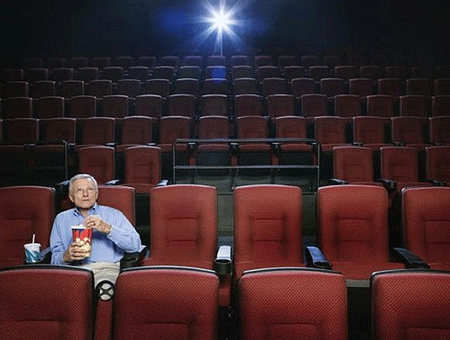Movie theaters after COVID
Part 1: What happened and will there be anything left?
In a three-part series, Center director Jeffrey Cole explores what happened to movie theaters during the pandemic, how the movie studios used a natural experiment, and what the future will bring.
By Jeffrey Cole

September 28, 2021 — The experimenting is over, and after eighteen months the results are in: movie theaters are here to stay!
It may take years to learn whether workers fully return to the office, students to the classroom, and shoppers to stores, but even while COVID is still raging we already know that movie fans will return to the theater.
In the darkest days of lockdown, streaming usage soared when people couldn’t go to the theater. Out of streaming emerged at-home hits like Tiger King, The Queen’s Gambit and Ted Lasso. It looked like it might not matter if theaters ever re-opened. Streaming was both more convenient and less expensive.
Now, the evidence is clear that the theater remains an essential part of the film distribution chain, especially for high-profile and big-budget films.
The experiment that almost wasn’t
If the movie theater owners had their way, there never would have been any experiments at all. Just the discussion of narrowing the 90-day window between the theater and streaming made them confrontational. When in 2011 Universal attempted to shorten the window for the Eddie Murphy-Ben Stiller action film Tower Heist to three weeks, the cinema owners threatened to boycott the film. Any discussion of releasing films into the theater and home on the same day with no window (the industry jargon for this is “Day & Date”) provoked theater owner threats to boycott a studio’s entire output.
Cinema owners liked film distribution the way it was and would tolerate little tinkering. Experimentation meant weakening their grip on new releases. They weren’t willing to risk disrupting the chain.
Then came March of 2020. Within days theaters were closed. Some films had already opened in theaters but had not completed their runs and were stuck in limbo.
A slate of big-budget films was scheduled to open in the following months (Wonder Woman 1984, No Time to Die (James Bond), Black Widow, and Tenet). Paramount had already launched an expensive marketing campaign for A Quiet Place 2, scheduled to open March 20, 2020.
The exhibitors (movie theater owners) would have preferred if the studios had held all these films until after the pandemic was over. Almost everyone assumed that would be within a few months. As the months dragged on and it became clear the pandemic was not receding, the studios realized they had a unique opportunity to experiment with different sorts of film release.
No great crisis should go to waste.
This time, there was nothing the theater owners could do to stop the experiments. It looked like one or two of them might declare bankruptcy, and threats of boycotts were hollow.
The studios could learn how much consumers would pay for a movie that had never been in theaters. Would fans pay a surcharge beyond their subscriptions to Netflix or Disney+ for a new film? How should those films be priced: $10, $30, or even $50? Would fans still pay to see a film in the theater if it was available at the same time on streaming (with and without an additional charge)?
Two billion-dollar “coulds”
The two questions I was most interested in were 1) could there be a billion-dollar film without a theater? and 2) could a studio build a franchise on a streaming channel?
Until COVID, billion-dollar movies were the core of the theatrical movie business. In 2019 (the last year of the old movie world) there were nine billion-dollar movies. Seven-and-a-half of them came from Disney (Spider-Man: Far from Home was a joint-production with Sony).
The first to innovate with new release patterns was Universal, whose new CEO, Jeff Shell, had taken charge a few months before COVID. Shell seized the opportunity to experiment with different distribution options. He took a sequel, Trolls World Tour, released it directly to streaming (independent of any subscription) at a cost of $20, and ultimately generated $100 million of revenue.
Was Trolls a success without the theater? It’s complicated. Trolls in the theater in 2016 grossed $153 million domestically. The streaming sequel earned less but didn’t have to share any of the revenue with theaters (the studio and the exhibitors usually share box office). And it was a sequel, which usually don’t do as well as the original. Trolls showed there were options, especially while theaters were closed.
As the country’s most successful movie studio, Disney was hurt most by the closing of theaters. Adding to that pain was the closing of Disney’s theme parks and cruise ships. Fortunately for Disney, it had launched Disney+ four months before COVID and was ready with an at-home service as the virus arrived and audiences were stuck at home.
Disney stock was crushed at the beginning of COVID. By March of 2020 it was down to $85. Within a year, thanks largely to its streaming service, it was up to $201.
If the movie theater owners had their way, there never would have been any experiments at all. Just the discussion of narrowing the 90-day window between the theater and streaming made them confrontational. When in 2011 Universal attempted to shorten the window for the Eddie Murphy-Ben Stiller action film Tower Heist to three weeks, the cinema owners threatened to boycott the film. Any discussion of releasing films into the theater and home on the same day with no window (the industry jargon for this is “Day & Date”) provoked theater owner threats to boycott a studio’s entire output.
More data needs to be collected, but it was clear films released directly into the home could generate respectable revenues. But could at-home replace the movie theater?
Disney+ and Apple TV+ were two new services without enough programming for a nation at home with little to do but watch television. Disney took Artemis Fowl and Hamilton (and later, Soul) and moved them directly to Disney+. Apple purchased the Tom Hanks World War II thriller Greyhound from Sony (now the only studio without a streaming channel of its own) and made it available as part of the basic subscription. It’s impossible to know how these films would have done in theaters or with premium charges added to subscriptions. They did provide high-profile content to the streamers.
Later in the summer of 2020, Disney released its live action Mulan to Disney+ (no theaters) with an additional $30 fee. The results were disappointing. Was the $30 price point too high, was Mulan the wrong choice for a premium fee, or was it just not a very good film? Eventually those questions would be answered with more data points.
WarnerMedia’s experiment
Christopher Nolan, the hugely successful director of the Dark Knight series, was pushing Warner Bros. after several delays to release his new film, Tenet, quickly (September 3, 2020) and only in theaters. Many hoped it would be the film to bring fans back to moviegoing. But COVID was still raging, and it was a bad decision. The $200 million film took in $36 million at the box office. Tenet was another data point that led to more questions: Were people not ready for the theater or had they already grown comfortable with watching big movies at home?
Tenet scared the other studios so much that Black Widow, No Time to Die, Top Gun: Maverick, and others saw their theatrical releases pushed back months or longer to outlast COVID.
Warner was shaken by its Tenet experience and the fear that fans might not return to theaters for a long time, if ever. Beginning with Wonder Woman 1984, it released all of its 2021 films on its newish streamer: HBO Max. Some of the films would also be released into theaters, providing a real test of Day and Date. WarnerMedia had so botched the unveiling of HBO Max that it sacrificed all those films to attract subscribers to its enhanced HBO service.
Theater owners were outraged, fearful that if this move really worked it might mean the permanent end of movie theaters. But, with theaters closed because of the pandemic, there was nothing they could do. Warner also outraged the producers and stars of some of these movies (In the Heights, Dune, The Matrix) who felt their films would never get the attention they deserved without an exclusive theatrical run, and they would also be denied millions of dollars in profit participation from box office grosses. Privately Warner paid tens of millions (probably closer to $200 million) to soften the anger of the talent and producers behind those films.
Next — Part II: A summer of experimentation
____________

Jeffrey I. Cole is the founder and director of The Center for the Digital Future at USC Annenberg.
See all columns from the center.
September 28, 2021

